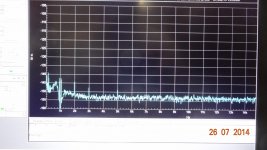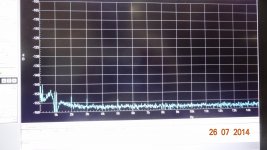Fortunately the last few weeks were a little less busy than usual so I could spend one or the other day for working on my low distortion oscillator. The mechanical design is almost done, a preview on the frontpanel: ultra_low_distortion_oscillator_frontpanel.pdf.
Samuel
Hi Samual,
Which FFT windowing is the most accurate for low level harmonic measurements? I have used the Flat Top and find the Hann gives about 9dB lower measured data numbers.
THx-RNMarsh
Last edited:
It isnt good enough for 24 bit level.... 16 bit maybe. Look up -- Electronic Design article..... Choose Right FFT Window Function When Evaluating precision ADC's.
-RM
One of the reasons I went with Mdac tuning is so the user can get as close as possible to a frequency to do coherent sampling and thus not need a window.
Just about every sar adc data sheet is done at a frequency that allows coherent sampling. No windows are used.
Last edited:
IIRC hann has a +/- 3db ripple of the level.
QuantAsylum did a basic windows explanation in the QA400 manual.
Do you have a link to the Manual? QA does not show it on their site for some reason.
Do you have a link to the Manual? QA does not show it on their site for some reason.
It's too big to upload here.
The QA400 manual is included in the SW download from QA.
Install the SW and extract the PDF.
https://www.quantasylum.com/content/Support/Downloads.aspx#QA400
Install the SW and extract the PDF.
https://www.quantasylum.com/content/Support/Downloads.aspx#QA400
One of the reasons I went with Mdac tuning is so the user can get as close as possible to a frequency to do coherent sampling and thus not need a window.
Just about every sar adc data sheet is done at a frequency that allows coherent sampling. No windows are used.
yes. So that is why the such fine freq tuning ability. [also useful with a fixed freq notch filter]
And using the A-P allows for coherant sampling (probably phase locked). So I can use Flat Top? In any case, not a Hann.
But if you use a sound card and external osc.... you may need windowing or have windowing which should not be used.
See here.... View attachment FFT WINDOWs.pdf
So. If others do tests they may need a window or not be aware of the requirments needed to avoid it.
But if used a very particular window for these levels to be accurate. One should state if they are using a window and which one.
THx-RNMarsh
Last edited:
yes. So that is why the such fine freq tuning ability. [also useful with a fixed freq notch filter]
And using the A-P allows for coherant sampling (probably phase locked). So I can use Flat Top? In any case, not a Hann.
But if you use a sound card and external osc.... you may need windowing or have windowing which should not be used.
See here.... View attachment 430104
So. If others do tests they may need a window or not be aware of the requirments needed to avoid it.
But if used a very particular window for these levels to be accurate. One should state if they are using a window and which one.
THx-RNMarsh
What is sown here is a not an amplitude error. A window does affect how deep into the noise a measurement can go. There is other documentation that compares the amplitude errors between windows. QA did this.
Look at table 3 here in this doc. It give a comparative amplitude error for several popular windows.
The Fundamentals of FFT-Based Signal Analysis and Measurement in LabVIEW and LabWindows/CVI - National Instruments
The Fundamentals of FFT-Based Signal Analysis and Measurement in LabVIEW and LabWindows/CVI - National Instruments
Lets back up. When I use Hann, I get amplitude error or when I use Flat Top I get a different amplitude. Which is correct one to use with the A-P?
THx-RNMarsh
You choose between noise power and amplitude error. As for the AP. Samuel or others with APs can answer this question better. But it shouldn't make any difference which analyzer is used. FFT is FFT with fixed mathematical relations.
Lets back up. When I use Hann, I get amplitude error or when I use Flat Top I get a different amplitude. Which is correct one to use with the A-P?
THx-RNMarsh
Here is a couple of interesting reads.
http://www.virtins.com/doc/D1003/Ev...ow_Functions_using_Multi-Instrument_D1003.pdf
http://www.virtins.com/doc/D1002/FFT_Basics_and_Case_Study_using_Multi-Instrument_D1002.pdf
Last edited:
Thank you, all. The Hann gives excellent resolving power for the first -50dB down. The Flat Top is better from -50dB and lower.
Here is the A-P results of using its own internal osc/gen with the Flat Top and using the Hann at < -140dB levels:
As you can see, there is a 4-6dB difference. [as reported, I have seen with other higher levels of thd/spectrum, differences of 9dB]:
 Flat Top
Flat Top
 Hann
Hann
In all cases, the Hann always gives the more optimistic number.
I tend to think the higher amplitude number is more accurate. But, how does the noise floor difference relate to this difference in measured levels? I notice it is the same level change as the harmonic amplitude differences... cant be a coincidence.
THx-RNMarsh
Here is the A-P results of using its own internal osc/gen with the Flat Top and using the Hann at < -140dB levels:
As you can see, there is a 4-6dB difference. [as reported, I have seen with other higher levels of thd/spectrum, differences of 9dB]:
 Flat Top
Flat Top Hann
HannIn all cases, the Hann always gives the more optimistic number.
I tend to think the higher amplitude number is more accurate. But, how does the noise floor difference relate to this difference in measured levels? I notice it is the same level change as the harmonic amplitude differences... cant be a coincidence.
THx-RNMarsh
Last edited:
It depends on the resolution used. How much noise power is in the bin, the width of the bin
and measurement bandwidth. At different RBW you'll get different results.
Nothing changed between the 2 tests.... same BW and same rbw etc.
OK for now... just note the difference of an average of 5-6dB in levels. And, if we dont standardize on one or the other window filter for these tests. That is -- if I measure -146 and it is -151dB with a Hann FFT window filter... it is really the same DUT. The noise change is due to filter BW and shape.
I'll look into Rife also.
THx-RNMarsh
Last edited:
Nothing changed between the 2 tests.... same BW and same rbw etc.
OK for now... just note the difference of an average of 5-6dB in levels. And, if we dont standardize on one or the other window filter for these tests. That is -- if I measure -146 and it is -151dB with a Hann FFT window filter... it is really the same DUT. The noise change is due to filter BW and shape.
I'll look into Rife also.
THx-RNMarsh
You shouldn't be getting that much of a difference. I certainly don't just using a active TT, Emu0204 and ARTA. Something else is going on. You need to here from someone more familiar with the AP. What I see between flattop and hann is a higher noise floor with flattop. Very little difference in harmonic level.
- Home
- Design & Build
- Equipment & Tools
- Low-distortion Audio-range Oscillator